Since I am going to Department of Veterinary Services for spaying demonstration in cats tomorrow, I think I should have started basic knowledge about cat's neutering technique before we start out surgery class next semester on year 3 :)
***************************************************************
A vet doing neutering in female cat
Neutering, is the removal of an animal's reproductive organ, either all of it or a considerably large part. It is the most drastic surgical procedure with sterilizing purposes.
Female Cat (Queen)
Spaying or desexing is the surgical removal of a female (queen) cat's internal reproductive structures, including her ovaries (site of ova/egg production), Fallopian tubes, uterine horns (the two long tubes of uterus where the foetal kittens develop and grow) and a section of her uterine body (the part of the uterus where the uterine horns merge and become one body).
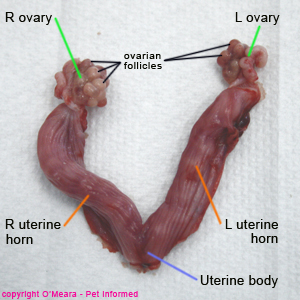
Part of female reproductive organ that have been removed via spaying
Basically, the parts of the female reproductive tract that get removed are those which are responsible for egg (ova) production, embryo and fetus development and the secretion of the major female hormones (oestrogen and progesterone being the main ones).
Removal of these structures plays a big role in feline population control; feline genetic disease control; the prevention and/or treatment of various medical disorders and female cat behavioral modification (e.g. estrogen is responsible for many female cat behavioral traits that some owners find problematic - e.g. roaming, calling for males - and spaying, by removing the source of female hormones like estrogen, may help to resolve these issues).
Spaying procedure
1. Anesthesia
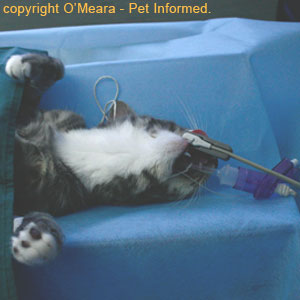
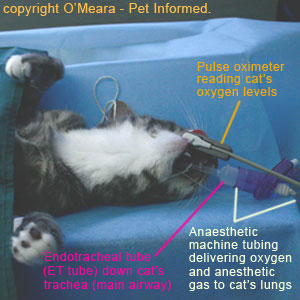
The cat must be anesthetised prior to spay surgery being performed, both so that it will not move whilst the spaying procedure is being performed and also so that it will not experience any pain.
The cat is given a series of injectable sedative and general anesthetic drugs to make it go to sleep (fall unconscious); an endotracheal (ET) tube is placed down its trachea (main airway) to help it to breathe better and to keep its airway free of vomit and other secretions and the cat is maintained under anesthesia by the addition of anesthetic gas vapours to the oxygen that it breathes (the oxygen and anesthetic gas vapors are supplied by an anesthetic machine, which is linked to the cat's endotracheal tube).
2. Shave belly-to remove the fur at the site of spaying
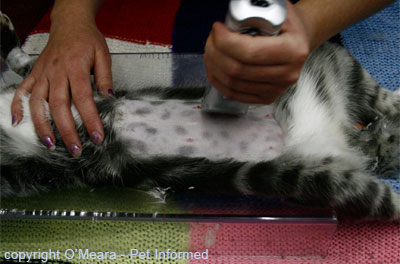
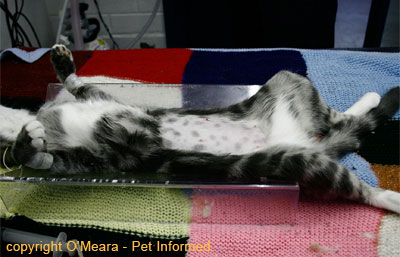
3. Scrub the surgical site
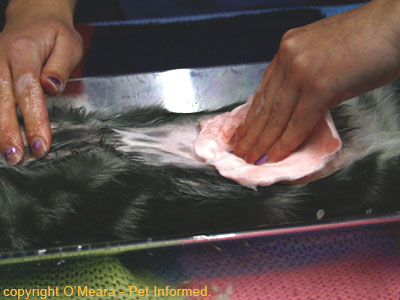
Female cat's abdomen (surgical site) being scrubbed with an antiseptic, antibacterial solution (chlorhexidine scrub and alcohol) prior to desexing surgery. This pre-surgical skin preparation reduces the amount of bacterial contamination that is present on the skin prior to the first incision being made.
4. Draping the cat spay site
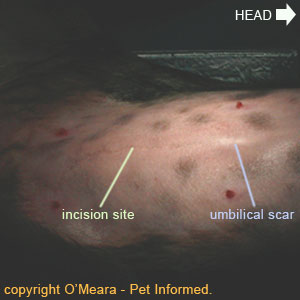
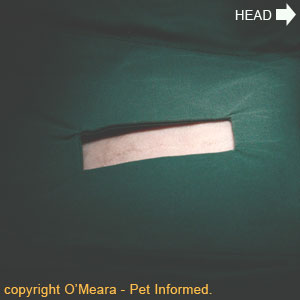
A sterile surgical drape is placed around the surgical site. This drape acts to focus the veterinary surgeon's attention on the spay site. It also acts to cover up the non-surgically-prepared, contaminated regions (e.g. the furred, unclipped regions) located outside of the shaved and prepped site so that the veterinarian can not accidentally touch them and inadvertently contaminate the surgical site. Additionally, the drape also provides a sterile surface for the vet to rest instruments periodically during surgery.
5. Incised the skin
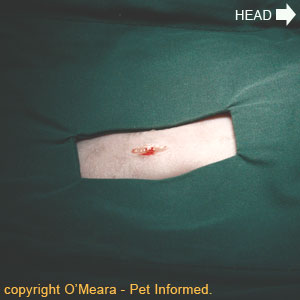
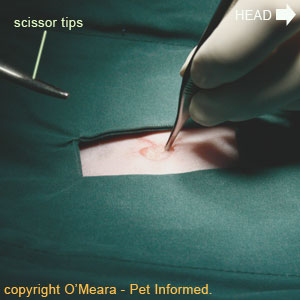
In this image, the veterinary surgeon is removing some of the fat (termed subcutaneous or SC fat) from the incision line region. The fat is the white, shiny substance in the centre of the incision line. There is generally a lot of fat located between the cat's skin and its abdominal wall muscles. The veterinarian will often cut a small amount of this fat away, allowing easy access to and visualisation of the cat's abdominal wall muscles.
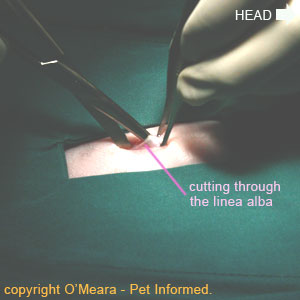
The veterinarian enters the cat's abdominal cavity by cutting through the abdominal wall musculature on the midline of the abdomen. The veterinarian aims to cut along a central line of scar tissue that joins the right and left sides of the animal's abdominal wall musculature. This line of scar tissue is called the linea alba (literally meaning - "white line"). By cutting through scar tissue, rather than the red muscle located either side of the linea alba, the veterinarian reduces the amount of bleeding incurred in entering the cat's abdominal cavity.
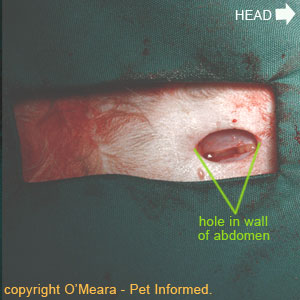
6. The 1st uterine hone is revealed
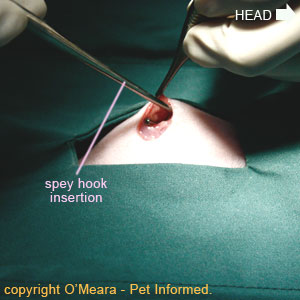
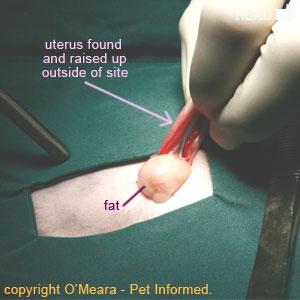
First uterine horn being lifted up and drawn out through the abdominal incision line.
7. The ovarian blood vessels are clamped and ligated
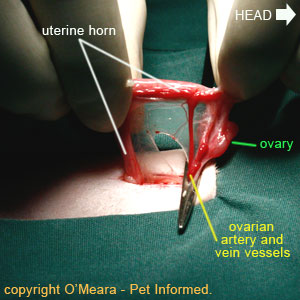
The blood vessels (artery and vein) supplying the cat's ovary are elevated and clamped off using mosquito hemostats (artery forceps). These hemostat clamps crush and traumatize the ovarian blood vessels, causing them to spasm and narrow in diameter, thereby aiding in preventing excessive ovarian pedicle hemorrhage when the ovary is cut off.
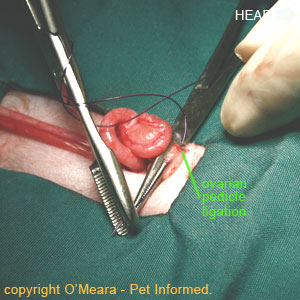
A suture (stitch) is placed around the blood vessels supplying the ovary (the general term for the blood vessels - artery and vein - supplying the ovary is the ovarian pedicle). This suture ties off and occludes the ovarian blood vessels supplying the ovary, thereby preventing excessive ovarian pedicle hemorrhage when the ovary is cut off.
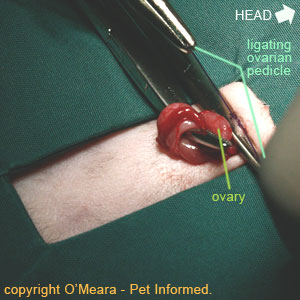
Suture (also called a ligature) being placed around the blood vessels supplying the ovary. This suture ties off and occludes the ovarian blood vessels supplying the ovary, thereby preventing excessive ovarian pedicle hemorrhage when the ovary is cut off. Once the ligature has been tied and knotted tightly, the long suture ends are trimmed away leaving only a small knot behind
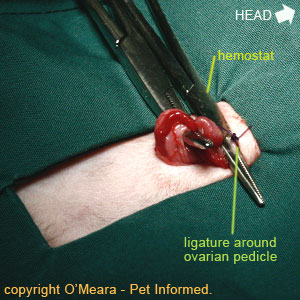
8. The ovarian pedicle is cut above the suture
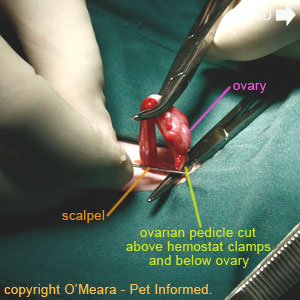
A scalpel blade is used to cut through the ovarian pedicle (ovarian artery and vein) supplying the ovary. The cut is made above the level of the hemostat clamp and the ovarian pedicle ligature so that the blood vessels (in particular, the ovarian artery) will not bleed when they are incised, but below the ovary such that the ovary will be removed from the ovarian pedicle when the cut is made.
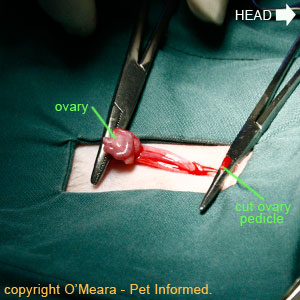
The appearance of the ovarian pedicle after the cut has been made. The hemostats are still in place in this image with the ligature located beneath them (hidden from view in this pic) - the hemostats will be removed, allowing the ovarian pedicle and its ligature to return back inside the abdomen. The ovary, still attached to its uterine horn, is reflected caudally (towards the animal's tail).
9. Steps 6-8 are repeated for the second uterine horn
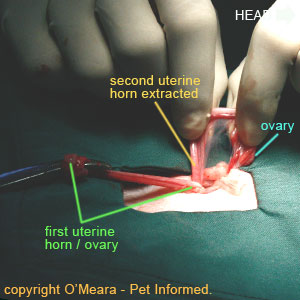
Second uterine horn being lifted up and drawn out through the cat's abdominal spay incision line.
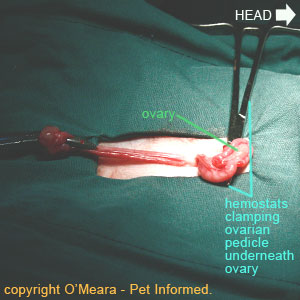
The blood vessels (artery and vein) supplying the cat's second ovary are elevated and clamped off using mosquito hemostats (artery forceps). These hemostat clamps crush and traumatise the ovarian blood vessels, causing them to spasm and narrow in diameter, thereby aiding in preventing excessive ovarian pedicle hemorrhage when the second ovary is cut off.
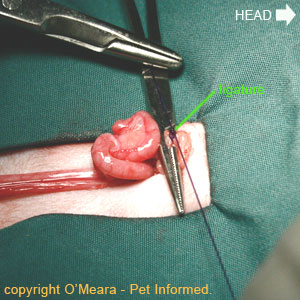
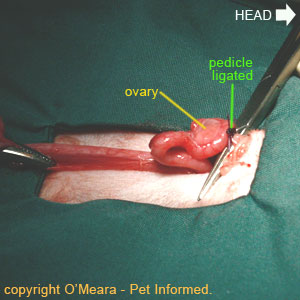
As occurred with the first ovarian pedicle, a suture (also called a ligature) is placed around the blood vessels (termed the ovarian pedicle) supplying the second ovary. This suture ties off and occludes the ovarian blood vessels supplying the ovary, thereby preventing excessive ovarian pedicle hemorrhage when the ovary is cut off. Once the ligature has been tied, the long suture
ends are trimmed away, leaving a small knot behind
Following the placement of this ligature, a scalpel is then used to cut through the ovarian pedicle supplying the second ovary. The cut is made above the level of the hemostat and the ovarian ligature (suture) so that the blood vessels (in particular, the ovarian artery) will not bleed when they are incised, but below the ovary such that the ovary will be removed (along with the uterine horn) from the ovarian pedicle when the cut is made.
10. The uterine body is revealed and ligated
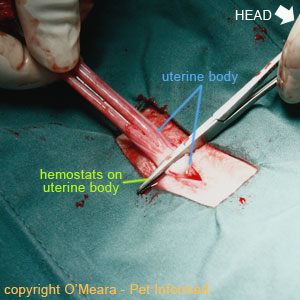
The two uterine horns are pulled caudally (towards the cat's tail) until the uterine body (the place where the two uterine horns merge and become one uterus body) is revealed and elevated above the level of the skin incision (where it is easily accessible to the surgeon). One or more hemostats are clamped across the uterine body, below the level of the uterine horns and just above the level of the cervix (the cervix is a sphincter-like muscle band located further down the uterine body, which forms a physical barrier between the abdominally-located uterus and the pelvically-located vagina).
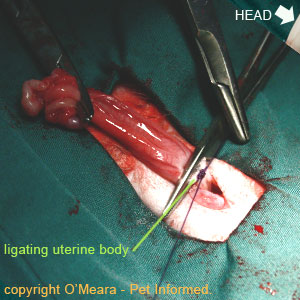
A suture (ligature) is placed around the uterine body. The suture's role is to close off the tunnel leading into the uterus from the outside world. This will prevent bacteria from entering the abdominal cavity, via ascension from the vagina, once the uterus is removed. The uterine body ligature also acts to occlude the uterine blood vessels (the uterine arteries and veins), which run along each side of the uterine body and supply the uterus, thereby stopping them from hemorrhaging once the uterine body has been excised (cut off).
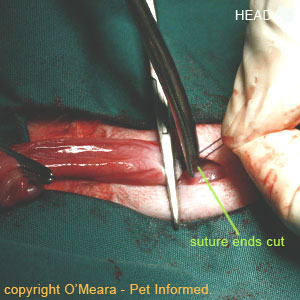
The ligature is now tied around the feline uterine body and the surgeon is just cutting the long suture ends away from the knot. Vet surgeons don't like to leave a lot of excess suture material lying around inside an animal's abdomen. Excess suture material can lead to irritation and inflammation occurring inside the abdomen and cause adhesions (where the organs get stuck together by scar tissue) to form between organs.
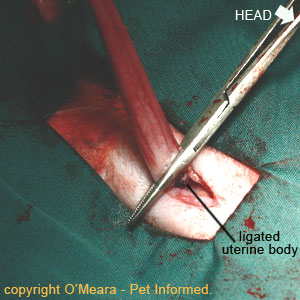
The appearance of the ligature once the long suture ends have been cut off the knot.
11. A second ligature is placed around the uterine body
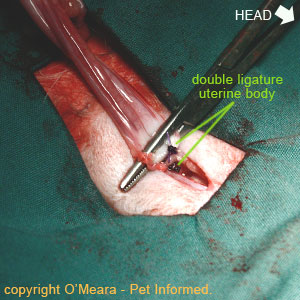
12. The uterine body is cut-off
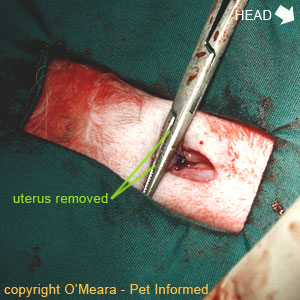
The uterine body is transected (cut off) above the level of the ligatures. This essentially completes the process of removing the uterus from the female cat. The animal will now no longer be able to reproduce. This is an irreversible surgical procedure.
13.The abdominal wall is sutured closed
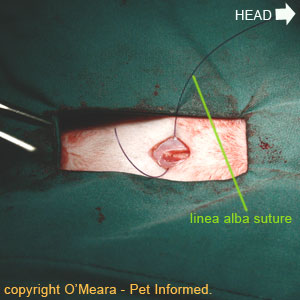
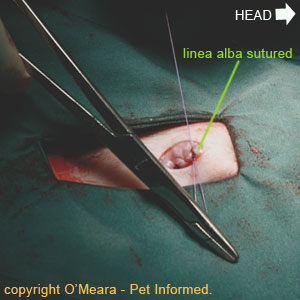
The surgeon uses absorbable suture material to close the hole in the abdominal wall musculature (linea alba). Because the linea alba is essentially a tendon-like, collagenous structure (made of collagen), it has less blood supply than red muscle and, therefore, takes longer to heal than muscle would. To take this slower healing into account, the veterinarian often uses a longer-lasting suture (a suture that is slower to lose its strength and slower to absorb) to close the linea alba. Because this suture absorbs over time, the vet does not have to remove it later on.
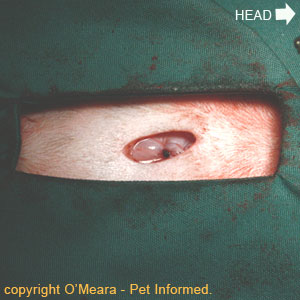
The linea alba has been sutured closed.
14. The subcut fat layer is sutured close
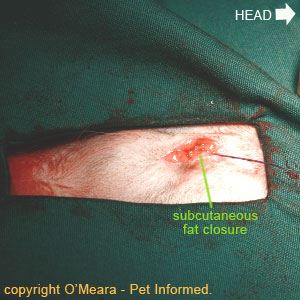
The subcutaneous fat layer (also called the SC or sub-q layer) is sutured closed. This layer closure acts to reduce the amount of open space (called 'dead space') located between the abdominal wall and skin layers, thereby reducing the risk of a large, fluid-filled swelling (called a seroma) forming at the surgery site. Basically, whatever space/gap you leave in a surgery site, fluid will pool in - by closing down this open space (dead space), the vet surgeon essentially leaves fewer sites available for inflammatory fluids to pool in.
15. The skin layer is sutured close
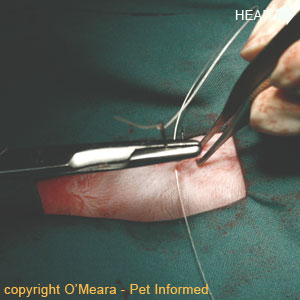
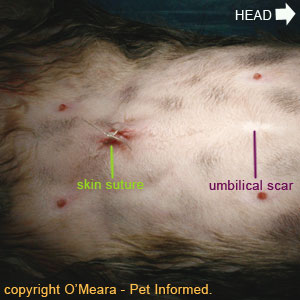
The surgeon is closing the skin using non-absorbable skin sutures. These will need to be removed in 10-14 days.
NOTE - absorbable skin sutures can also be placed. These are called intradermal sutures and they do not need to be removed.
The final result : The newly desexed cat
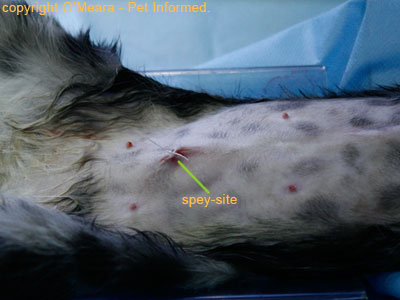
ps: I will post about cat castration (male cat's) in the later post
ps: A veterinary guide to cat spaying procedure; www.pet-informed-veterinary-advice-online.com




















1 comments:
Nice article on health
Post a Comment